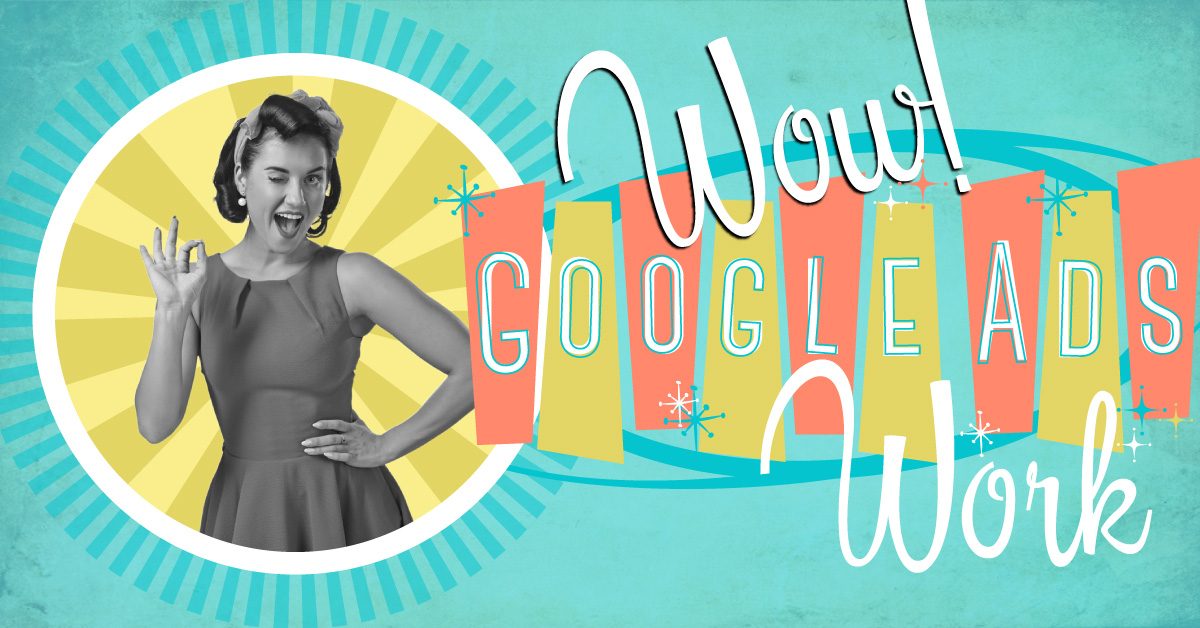People often tell us that Google Ads, aka Google AdWords, DO NOT WORK. They say that nobody clicks on the ads, it costs too much, and it just does not work. They have tried them and that’s that.
 As a PPC Agency, we take a deep breath and reply “I accept the fact they did not work for you, but they do work.” This leads to a colorful conversation that is always entertaining and enlightening. Let’s explore the common issues people raise against Google Ads and see if they resonate with you.
As a PPC Agency, we take a deep breath and reply “I accept the fact they did not work for you, but they do work.” This leads to a colorful conversation that is always entertaining and enlightening. Let’s explore the common issues people raise against Google Ads and see if they resonate with you.
With Great Power Comes Great Responsibility
Google Ads are a powerful tool and powerful tools must be used with respect and care. At its core, Google Ads is just a tool and when used properly it can work wonders. Disrespect Google Ads and it will set your credit card on fire with complete disregard for your financial safety.
Nobody Clicks on the Ads
This is a self-healing issue because if nobody clicks on the ads then it costs you nothing; nothing ventured nothing gained. Google earns $100 billion a year and 96% of that comes from Google Ads so if nobody clicks on the ads, why is Google so rich! Like most statements, there is a degree of truth in this one. Some estimate that organic listings get 80% or more of the overall traffic and that makes sense. A large percentage of searches are for research and almost all those clicks go to organic listings. People click on the ads when they want to find a vendor to buy a product or service from and this is typically the traffic you want. To compete effectively, you have to play both sides of Google. You need an organic content strategy for the research traffic and a PPC strategy for the buyers.
It Costs Too Much
This is sometimes true but it usually means something is wrong. Some people look at business as a cost control mission and the problem with this is that they can save their business out of existence. These people have a first priority to spend less when the real mission is to spend as much as you can at a reasonable cost per acquisition. Google Ads have to be managed from a maximum value perspective.
It’s true that Google Ads can cost too much and when true, the fix is to use the tool properly. It’s not fair to blame a screwdriver for not doing a good job driving nails; the same can be said about Google Ads. Step one in this process is to calculate and understand your target cost per conversion. As long as you achieve your target conversion cost, you should SPEND MORE, not less.
We have seen situations where Google Ads have been the wrong tool for the job. When this happens you have to look at how the tool is being used. If Google Ads is not creating more value than it costs then you are not done engineering the campaign. Roll up your sleeves and get back to work.
Why pay for what I can get free?
When people say free traffic, what they really mean is the organic listings created by your investment in SEO (Search Engine Optimization).
- SEO is only free if you have a source of free professional labor.
- You pay for SEO differently but you still pay for it.
To earn organic traffic you have to have a steady supply of fresh content that applies to your business. This requires labor for planning, writing, optimizing, and publishing this content has to be accounted for. Many owners have told me that this is their time so it really is zero cost. This means that they do not value their time, which in many cases is the most expensive time in the business. We have run hundreds of cost evaluations of Free traffic and most of the time it turns out to be the most expensive of all the traffic.
Organic listings are the PR of the internet and its great traffic but it is also highly competitive and ages poorly. Organic absolutely needs to be part of your Digital Marketing strategy but it’s very rare that a strategy can stand on a single tactic.
Organic also provides very little usable data. Analytics will give you the visitors for this traffic type but not the search query. This leaves the analysts guessing about what works. Google Ads data can greatly increase your knowledge of your organic performance.
It’s so Simple – I will just Do It Myself
The question is not can you but should you? At first blush Google Ads seems simple: throw a few keywords at it, write a few ads, and you’re up and running. Google certainly pitches Ads that way but it’s just not true. Do the minimum set up and you will surely get the minimum in return (if not less).
I equate this to basketball. At one end of the spectrum, there’s me; I know the rules, can dribble and shoot. On the other end, there’s Lebron James. He can play basketball as well but at a level that the majority of people will never reach. The question you have to ask is, what level do you want your Google Ads account?
I have worked professionally with Google Ads since July 7, 2003, and the system has increased in complexity every year so unlike basketball, the rules change constantly. You can operate Google Ads as a simple system and get simple results but if you want to play professionally, it requires dedicated time and effort. In a typical year, the system will go through hundreds of changes and competitors will constantly shift strategies. If you are lucky enough to have the time to stay up with this field and the business of your business then you can run Google Ads and we wish you the best.
There is also an economic component to consider. If your time is valuable then you should weigh the value you create in your business compared to the cost of outsourcing. In most cases, the internal value of a person with the skills to run Google Ads and your business greatly exceeds what you would pay an agency. So yes, you can run it yourself, the question is, should you?
The Keywords I selected did not give me the results I wanted
But you did get what you asked for. Keywords are not simple and they certainly do not work the way you want them to. Poor Keyword Models are the number one cause of poor account performance. Simply throwing keywords at the system is an accident waiting to happen.
You will burn through your budget by buying non-responsive traffic that creates nothing for your business. 90% of the accounts we take over suffer from this problem. We develop the keyword model from the most specific highest intent value words and then loosen the keyword model until we reach the balance point between budget and market share. Simply stated we want to be the most targeted traffic right up to the budget. In a recent case, the result of applying this strategy was a performance increase of over 300%.
A common criminal in this issue is broad match keywords, which truly are permission for Google to steal your money. These will surely give you traffic that is NOT what you were thinking of.
The World Does NOT Revolve Around You
Let’s face it, most of us think the world revolves around us. In keywords, you have to think about how your customer and the rest of the universe uses the words in your keyword model. When taking over an internally managed account, we often find that the features are highlighted, not the benefits of the product to the consumer. Customers seek the benefits, not the features.
For example, we had a client that was in the music licensing business, meaning that they consulted on getting music rights for films. The challenge was that songwriters and musicians also use these exact same words for information about how they can license their music to projects. The clients business did not serve songwriters or musicians but that traffic is the majority of the keyword music licensing. In our terms, these are gray words and to manage an account you have to realize that your budget burn can be driven by people out of your target. When managing these words you have to adjust bidding to bring the value in line with the cost.
It’s PPC so I don’t care about Impressions
You could not be more WRONG! You should care about impressions and here is why. In Google Ads, money comes in two forms; money as we all understand it and quality score. When your bid is processed, the ad rank is the money times quality. Stop and think for a second here – increasing your quality score reduces the amount of money you have to spend for the exact same ad position. Consider this simple example:
| Bid | Quality Score | Ad Rank | Win/Lose |
| $1.00 | 3 | 3.00 | Loser |
| $.43 | 7 | 3.01 | Winner |
Spend Quality or Money – it’s your choice
So what does this have to do with impressions? Well, the largest part of the quality score is the click-through rate, which is clicks divided by impressions. Improve the CTR and you drive your quality score up meaning that you spend less and get more. This is Google’s way of rewarding advertisers that pay attention to and help create a quality Search Engine Results Page.
Quality Score Conflict or Synergy?

Google’s agenda and yours are not always in sync and CTR is an example of this. If you create a design with a keyword model and ad copy that creates a lower CTR then you are in conflict. Google believes at its core that CTR is an indicator of quality and in many presentations, we have seen them represent it as the BIGGEST indicator. In most cases, a higher CTR is a good thing but there are exceptions.
A client in the Web Design business came to us with a quality problem. Their Google quality score was above average but as the discussion evolved, it became clear that their quality problem was their quality, not Google’s. This business did high-end work with minimum projects starting well over $10,000. The agency before us judged their work on the Google Quality Score and based on that measure, they did a good job. The challenge is that 99% of the traffic volume for web designers is for projects well below this level.
To resolve this we changed the headlines and included the $10k minimum project size. Both Click-through rate and quality scores dropped like rocks. By all Google measures and best practices, a horrible result but the client loved it! They spent less and got more and better leads. Before clicking on the ad, prospects knew this was a high-end design solution.
Competitors click on Google Ads

Nobody likes to talk about this but Click Fraud does exist. Google Ads is not perfect but this is not as big a problem as some think. Google does a good job of detecting click fraud automation and has spent billions protecting Google Ads from it. The days of accounts being impacted by a competitor burning through your budget by constantly clicking on your ad are long gone. Google’s technology cleans that up and removes it from your account every day.
The difference between good and bad traffic is the intent of the person on the keyboard. If they have no intent to use your services or buy your products but rather have the intent of draining your budget that clicks fraud. The challenge is there is no “intent sensor”. Much of the traffic is early stage purchase research and while it has no intent on this visit to buy your product or service it can very easily be moving the prospect through the sales funnel.
Some propose that bounce rate is an indicator of click fraud and this is sometimes true. The definition of a bounce is landing on one page and then leaving your website, which at first blush, seems like bad traffic. However, you might change your perspective if I told you that a bounce can also be good traffic. For example, a customer clicks on your ad, sees your phone number, calls, and buys your product or service. Homerun! This is also a bounce so be careful what you think data means.
Click Fraud is part of the cost of doing business. You should still monitor and work to reduce this but realize that the world is not perfect. There are lots of tools in Google Ads to protect your account like IP address blocking or negative geographic targets but most of this is a risk you just have to accept.


